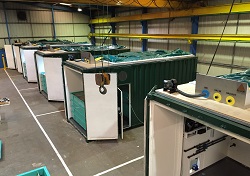Microbial fuel cells treat micro-scale industrial and agriculture waste
Disposal of organic waste streams is a major hurdle to the productivity and profitability of the EU’s agri-food and drink processing industries (a-FDPI). To-date, there is no feasible micro-scale technology for the safe disposal of organic waste or to recover some of the 288 Terawatt-hours of potential energy that exists in the a-FDPI sector as hydrogen/methane rich biogas. H2AD-aFDPI, an EU-funded initiative, has answered this challenge by developing a novel micro-scale technology for the rapid and safe disposal of organic effluents - termed H2AD. The technology is based on a highly efficient industrial biotechnology process that reduces the chemical oxygen demand (COD) of the organic content. The energy from the waste is then converted to hydrogen and methane-rich biogas. “The core technology is an integrated and closed loop microbial fuel cell (MFC), based on a novel hybrid of traditional anaerobic digestion and conventional MFC technology,” says engineering project manager, Darren Bacon. However, unlike conventional MFC technology, a microbial reaction with the potential for electrical stimulation is established in a completely anaerobic way. The result is a waste-to-energy process that rapidly reduces the COD and total suspended solids of organic waste streams to safe levels. Treating waste and providing energy Researchers built H2AD units for the pre and post treatment of organic waste at five sites across Europe. Each of the chosen sites offered a wide variety of organic wastes, representing an opportunity for ground-breaking waste treatment whilst obtaining energy rich biogas. “All five trial sites were successfully installed and commissioned, overcoming site specific challenges to deliver successful trials and solid results that prove the technologies effectiveness, reliability and adaptability,” observes Bacon. The purpose of the field trials was to confirm the predicted accelerated payback performance of H2AD for the treatment of organic effluents derived from different operational environments within the a-FDPI sector. Researchers measured H2AD performance and modelled predicted payback periods from slurry-fed H2AD for waste streams from fruit drinks processing, dairy processing, microbreweries and mixed agriculture. Benefits a large market Results revealed better than expected reductions in organic pollutants and the excellent composition of the biogas. According to Bacon: “In Valencia, Spain, project partners treated thickened waste from a local ice cream producer. High strength waste was consistently reduced in its COD by over 90 %, whilst developing biogas with a methane content of up to 80 %. These results far outweighed all expectations for the technology, especially for this challenging form of thickened waste sludge.” The project also showed that there was a large and diverse market that could benefit from H2AD technology, such as within the dairy sector, which includes cheese and ice cream production. “H2AD will pursue these markets during the first phase of commercialisation before entering into the soft drink, brewery, agriculture and general food production markets within the European arena and eventual into the wider international arena,” observes Bacon. “There are currently trials being organised for H2AD in the UK within the cheese-making, brewing, cider making and food industries to support our commercial activities,” he concludes.
Keywords
H2AD-aFDPI, organic waste, biogas, microbial fuel cell, anaerobic digestion







